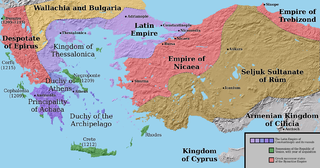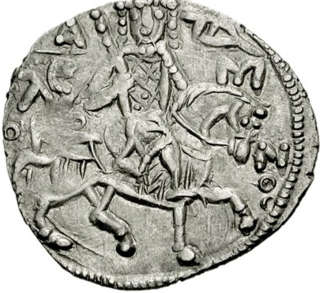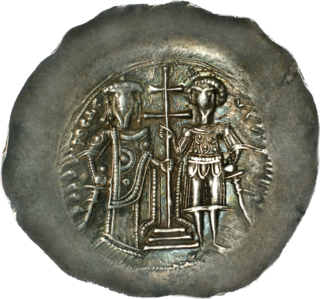
Michael VIII Palaiologos or Palaeologus reigned as Byzantine emperor from 1261 until his death in 1282, and previously as the co-emperor of the Empire of Nicaea from 1259 to 1261. Michael VIII was the founder of the Palaiologan dynasty that would rule the Byzantine Empire until the Fall of Constantinople in 1453. He recovered Constantinople from the Latin Empire in 1261 and transformed the Empire of Nicaea into a restored Byzantine Empire. His reign saw considerable recovery of Byzantine power, including the enlargement of the Byzantine army and navy. It also included the reconstruction of the city of Constantinople, and the increase of its population. His re-establishment of the University of Constantinople contributed to the Palaeologan Renaissance, a cultural flowering between the 13th and 15th centuries.

Theodore I Laskaris or Lascaris was the first emperor of Nicaea—a successor state of the Byzantine Empire—from 1205 to his death. Although he was born to an obscure aristocratic family, his mother was related to the imperial Komnenos clan. He married Anna, a younger daughter of Emperor Alexios III Angelos in 1200. He received the title of despot before 1203, demonstrating his right to succeed his father-in-law on the throne.
George Akropolites was a Byzantine Greek historian and statesman born at Constantinople.

The Latin Empire, also referred to as the Latin Empire of Constantinople, was a feudal Crusader state founded by the leaders of the Fourth Crusade on lands captured from the Byzantine Empire. The Latin Empire was intended to replace the Byzantine Empire as the Western-recognized Roman Empire in the east, with a Catholic emperor enthroned in place of the Eastern Orthodox Roman emperors. The main objective to form a Latin Empire was planned over the course of the Fourth Crusade, promoted by crusade leaders such as Boniface of Montferrat, as well as the Republic of Venice.

The Empire of Nicaea or the Nicene Empire was the largest of the three Byzantine Greek rump states founded by the aristocracy of the Byzantine Empire that fled when Constantinople was occupied by Western European and Venetian armed forces during the Fourth Crusade, a military event known as the Sack of Constantinople. Like the other Byzantine rump states that formed due to the 1204 fracturing of the empire, such as the Empire of Trebizond and the Despotate of Epirus, it was a continuation of the eastern half of the Roman Empire that survived well into the Middle Ages. A fourth state, known in historiography as the Latin Empire, was established by an army of Crusaders and the Republic of Venice after the capture of Constantinople and the surrounding environs.

The Empire of Trebizond or the Trapezuntine Empire was one of the three successor rump states of the Byzantine Empire that existed during the 13th through to the 15th century. The empire consisted of the Pontus, or far northeastern corner of Anatolia, and portions of southern Crimea.

The House of Palaiologos, also found in English-language literature as Palaeologus or Palaeologue, was a Byzantine Greek noble family that rose to power and produced the last and longest-ruling dynasty in the history of the Byzantine Empire. Their rule as Emperors and Autocrats of the Romans lasted almost two hundred years, from 1259 to the Fall of Constantinople in 1453.
Alexios I Megas Komnenos or Alexius I Megas Comnenus with his brother David, the founder of the Empire of Trebizond and its ruler from 1204 until his death in 1222. The two brothers were the only male descendants of the Byzantine Emperor Andronikos I, who had been dethroned and killed in 1185, and thus claimed to represent the legitimate government of the Empire following the conquest of Constantinople by the Fourth Crusade in 1204. Although his rivals governing the Nicaean Empire succeeded in becoming the de facto successors, and rendered his dynastic claims to the imperial throne moot, Alexios' descendants continued to emphasize both their heritage and connection to the Komnenian dynasty by later referring to themselves as Megas Komnenos.

John II Megas Komnenos was Emperor of Trebizond from June 1280 to his death in 1297. He was the youngest son of Emperor Manuel I and his third wife, Irene Syrikaina, a Trapezuntine noblewoman. John succeeded to the throne after his full-brother George was betrayed by his archons on the mountain of Taurezion. It was during his reign that the style of the rulers of Trebizond changed; until then, they claimed the traditional title of the Byzantine emperors, "Emperor and Autocrat of the Romans", but from John II on they changed it to "Emperor and Autocrat of all the East, the Iberians, and the Transmarine Provinces", although Iberia had been lost in the reign of Andronikos I Gidos.

Alexios II Megas Komnenos was Emperor of Trebizond from 1297 to 1330. He was the elder son of John II and Eudokia Palaiologina.
Eudokia Palaiologina or was the third daughter of Byzantine Emperor Michael VIII Palaiologos and his wife, Theodora, a grandniece of Emperor John III Doukas Vatatzes of Nicaea.

The House of Laskaris, Latinized as Lascaris, was a Byzantine Greek noble family which rose to prominence during the late Byzantine period. The members of the family formed the ruling dynasty of the Empire of Nicaea, a Byzantine rump state that existed from the 1204 sack of Constantinople by the Fourth Crusade until the restoration of the Empire under the Palaeologan dynasty in 1261.
The House of Angelos, Latinised as Angelus, was a Byzantine Greek noble family that produced several Emperors and other prominent nobles during the middle and late Byzantine Empire. The family rose to prominence through the marriage of its founder, Constantine Angelos, with Theodora Komnene, the youngest daughter of Emperor Alexios I Komnenos. As imperial relatives, the Angeloi held various high titles and military commands under Emperor Manuel I Komnenos. In 1185, following a revolt against Andronikos I Komnenos, Isaac II Angelos rose to the throne establishing the Angeloi as the new imperial family that ruled until 1204. The period was marked by the decline and fragmentation of the Byzantine Empire, culminating in its dissolution by the Fourth Crusade in 1204 under Alexios IV Angelos.
Alexios Komnenos Strategopoulos was a Byzantine aristocrat and general who rose to the rank of megas domestikos and Caesar. Distantly related to the Komnenian dynasty, he appears in the sources already at an advanced age in the early 1250s, leading armies for the Empire of Nicaea against Epirus. After falling out of favour and being imprisoned by Theodore II Laskaris, Strategopoulos sided with the aristocrats around Michael VIII Palaiologos, and supported him in his rise to the throne after Theodore II's death in 1258. He participated in the Pelagonia campaign in 1259, going on to capture Epirus, but his successes were undone in the next year and he was captured by the Epirotes. Released after a few months, he led the unexpected reconquest of Constantinople from the Latin Empire in July 1261, restoring the Byzantine Empire. He was captured again by the Epirotes in the next year and spent several years in captivity in Italy, before being released. He retired from public affairs and died in the early 1270s.

The mesazon was a high dignitary and official during the last centuries of the Byzantine Empire, who acted as the chief minister and principal aide of the Byzantine emperor. In the West, the dignity was understood as being that of the imperial chancellor.

The Reconquest of Constantinople was the recapture of the city of Constantinople in 1261 AD by the forces led by Alexios Strategopoulos of the Empire of Nicaea from Latin occupation, leading to the re-establishment of the Byzantine Empire under the Palaiologos dynasty, after an interval of 57 years where the city had been made the capital of the occupying Latin Empire that had been installed by the Fourth Crusade in 1204 following the Crusader Sack of Constantinople.

The struggle for Constantinople was a complex series of conflicts following the dissolution of the Byzantine Empire in the aftermath of the Fourth Crusade in 1204, fought between the Latin Empire established by the Crusaders, various Byzantine successor states, and foreign powers such as the Second Bulgarian Empire and Sultanate of Rum, for control of Constantinople and supremacy within the former imperial territories.










